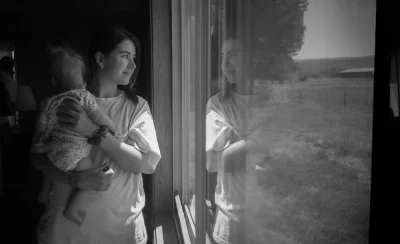
Warner Grandfield: Photos Reveal a Broken U.S. Maternity Leave System
Art
Warner Grandfield was living in a van in 2021 when his wife, Caitlin, called to tell him she was pregnant. “We Facetimed, and I just took a picture of the phone. I didn’t know what else to do,” he says. Taking photos was normal for Grandfield, but this felt different. Grandfield has since taken more than 540 photos, one each day, of his wife and baby throughout every stage of her pregnancy and his child’s early life. “I didn’t realize what I was doing until just recently. I was like, ‘Well, I can make a story out of this. There’s something here.’”
“She had gestational hypertension, but she was getting ready to go to work because she was the only one in her position and they wouldn’t hire anybody else to help her out.”
Grandfield first picked up a camera as a kid in the ’90s living in rural Texas. In 2011, he joined the Navy, working as a linguist and taking photos during his off time. “I’ve always been interested in languages, and photography is just a visual language that can overcome any kind of language barrier,” Grandfield says. After leaving his base in Texas, he joined the Reserves and enrolled at the University of Utah. It was a university photojournalism class that shifted his focus to documentary photography. “In photojournalism, you have to be neutral, but the whole reason I’m telling stories is because I am biased towards the stories I want to tell.”
It was around that time that Grandfield and Caitlin found out they were expecting. Like many couples, their next step was to investigate her maternity leave policy, but they quickly realized the benefits weren’t all that beneficial. “When they advertised the position to her, they said she would have paid maternity leave up to 12 weeks—they didn’t tell her she needed to save her PTO,” says Grandfield. “We also realized three months is no time at all for a new mother with a baby. After she had the baby, she has a dinner plate–sized wound in her gut that she’s still recovering from, and [employers] want you to come back to work.”
In the U.S., only 23% of workers have access to paid family leave through their employers according to the U.S. Bureau of Labor Statistics as of March ’21. Across countries in the intergovernmental Organisation for Economic Co-operation and Development (OECD), 186 countries offer paid leave for new mothers, and the U.S. is the only country without any form of national paid leave according to the OECD. “It’s unfair, it’s unjust [and] it’s infuriating,” Grandfield says.
“I didn’t realize what I was doing until just recently. I was like, ‘Well, I can make a story out of this. There’s something here.’”
Grandfield channeled his anger into his photos, creating a series documenting each stage of Caitlin’s pregnancy. During Caitlin’s third trimester, Grandfield snapped a photo of her sitting at the sink, exhausted, doing her makeup before work. “She was already having a hard time with the pregnancy,” he says. “She had gestational hypertension, but she was getting ready to go to work because she was the only one in her position and they wouldn’t hire anybody else to help her out.”
Now, Grandfield has a nine-month-old daughter. He isn’t sure when he’ll find a stopping point for his photo series, but he does know the lack of employment security and support for mothers in the United States maternity leave system is an issue that desperately needs to be talked about. “Maternity leave here in the states is almost non-existent. Every mother’s story is going to be unique and that’s part of the problem—they all have to navigate unique situations depending on their state or where they work,” he says. “If I was going to summarize that into just one quick statement it would be: This is unacceptable.”
Follow Grandfield’s work on Instagram, @warnergrandfield.
Read more on local photographers engaged in documentary work:
Forget the Photography, Remember the Story: For Rick Edgen, Photojournalism is About Changing Lives
Capturing the Moment with Michael Kunde




